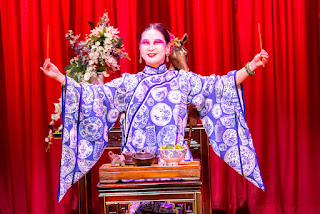Chinese immigration to the USA: The door creaks painfully open in 'The Chinese Lady'
The story of the restricted, uncomfortable movement of native Chinese to America proceeds from the
 |
| Teenage Afong Moy displays exotic chopsticks in the 1830s. |
unique story of how the first Chinese woman to come to the U.S. got here and what she learned and endured.
Afong Moy arrived in this country at 14 in 1834, she tells us repeatedly in "The Chinese Lady," which Indiana Repertory Theatre presents on the Upperstage through Nov. 6. This unprecedented pioneer presents her story through the kind of nesting-doll approach Lloyd Suh adopts for his 90-minute drama.
By that I mean that IRT patrons are presented with the performances Afong Moy was required to give as an exotic exhibit. Enclosing it, Suh sets down the historically advancing story as he takes the character from shy teen to senior citizen in her adopted homeland. The tension the play creates is a remarkable achievement. The IRT's mostly white audience is asked to balance the friendly exoticism of the 19th-century lecture-demonstration and what remains of the dominant culture's resistance to fully accepting today the "all sorts and conditions of men" that I was instructed to pray for as a young Episcopalian.
What Afong Moy is trained to see as an exercise in mutual understanding between alien cultures eventually puts cracks in her naivete as she matures. As a girl and young woman, she has transmuted her exploitation into what she chooses to interpret as natural curiosity about the Other. That is purported to lead to greater understanding and acceptance among cultures around the world. It often doesn't work that way, she finds out.
The character of Atung, the translator who accompanies Afong Moy in her presentations, looks at these thoroughly processed exhibitions with a jaundiced eye. For the captivated Americans, what is not seen as charming elegance (the cultural stature of tea) may be taken in as shocking barbarism (the drastic foot-binding practiced on upper-class Chinese girls). To him, it's all show biz masquerading as cross-cultural awareness.
 |
| Trieu Tran as Atung, the translator |
The employment of both Atung and Afong Moy eventually by the successful charlatan P.T. Barnum also leads to a break in their relationship after the title character is discarded by the famed 19th-century impresario. Atung (nobly and insightfully portrayed by Trieu Tran) is worn out by the misrepresentation and servitude his job demands of him. He comes to ruefully accept humiliation as part of the price he must pay as the result of white racism. On the other hand, Afong Moy is cast loose with her hard-won knowledge, and in brief scenes of time travel up to the present recounts the horrors of anti-Chinese prejudice in U.S. history.
 |
| IRT produces Lloyd Suh's play. |
The setting opens and closes repeatedly as each new stage of Afung Moy's story is revealed. Junghyun Georgia Lee's set manages to encompass both the emotional remove of the characters from their 19th-century audiences and the exoticism meant to impress it upon them.
In the title role Mi Kang miraculously changes Afong Moy's appearance and gradually aging manner of speaking and gesturing. In the October 21 performance I saw, at every stage she never failed to embody the character's appeal and constraints. In her role's larger sense, she conveyed the limitations to American understanding of and sympathy with Afong Moy's countrymen.
Ralph B. Peña's direction allows each actor to present a full-fledged portrait in which the identity remains but with the toll of lived experience effecting subtle but withering changes. The process calls to mind The Picture of Dorian Gray, but without the moral burden placed upon the Oscar Wilde character. If there's a moral burden to be placed anywhere, it's upon Americans past (and possibly present, too) who fail to rise to the challenge of seeing people unlike them as they really are and as they should be allowed to be. The dwindling white majority will not be able to avoid having its nose pressed into the mess it has made.
Other aspects of the production — Fabian Obispo's soundscape, Oliver Wason's lighting and Linda Cho's costumes — place us in a world of fantasy as appropriate, figuratively a two-way scrim through which Suh's characters and his audiences must labor to achieve authentic vision of one another.
The playwright has been selective in shedding light on aspects of anti-Chinese bias here. Not everything relevant to that can be covered in a play meant to examine one isolated victim's difficulties. Why Chinese immigrants were channeled into laundry and restaurant work in American big cities, for example, is another part of the story of how alien circumstances and dominant prejudices can shape group identity.
But Suh's focus on one woman programmed to advocate for universal understanding and respect, then discovering she is understood as a stereotype forced to stay as such or be rejected, is amply compelling and necessarily strikes the American conscience deeply.
[Photos by Noelani Langille and Zach Rosing]



Comments
Post a Comment